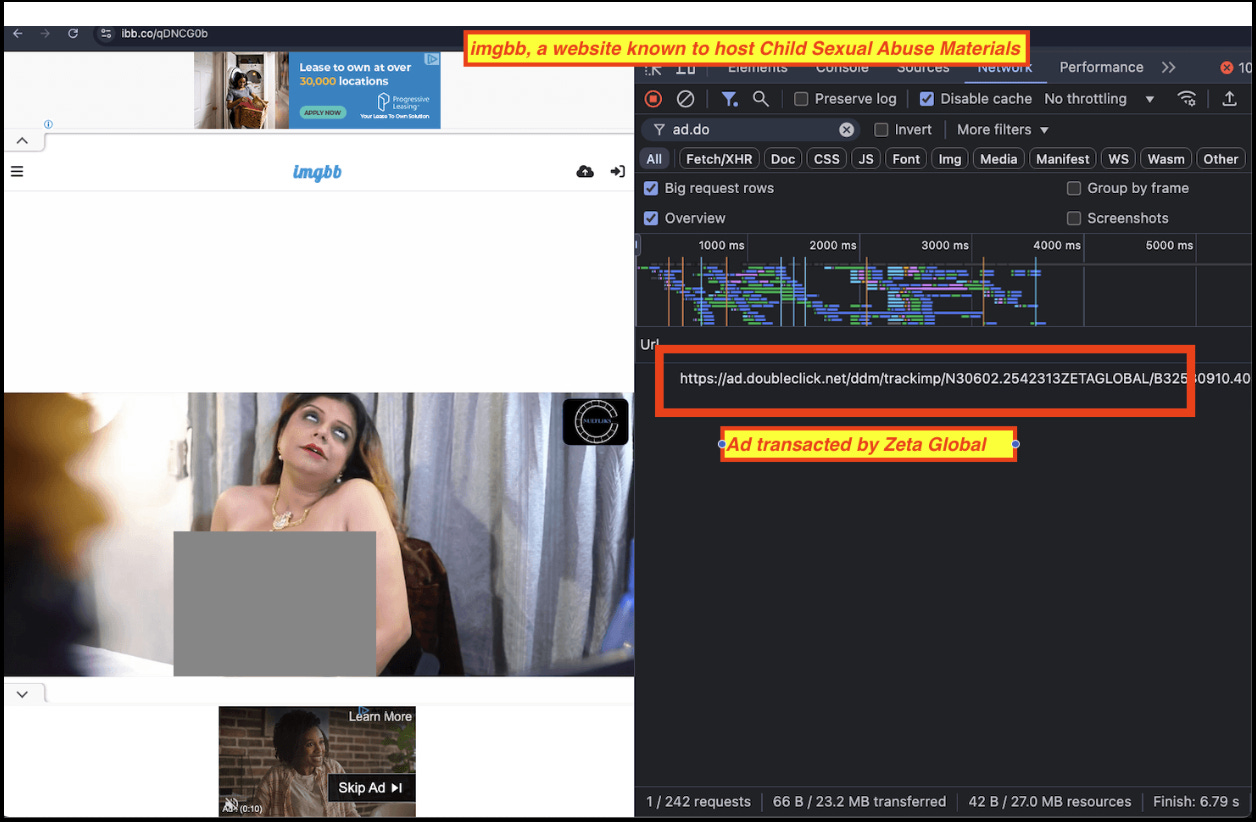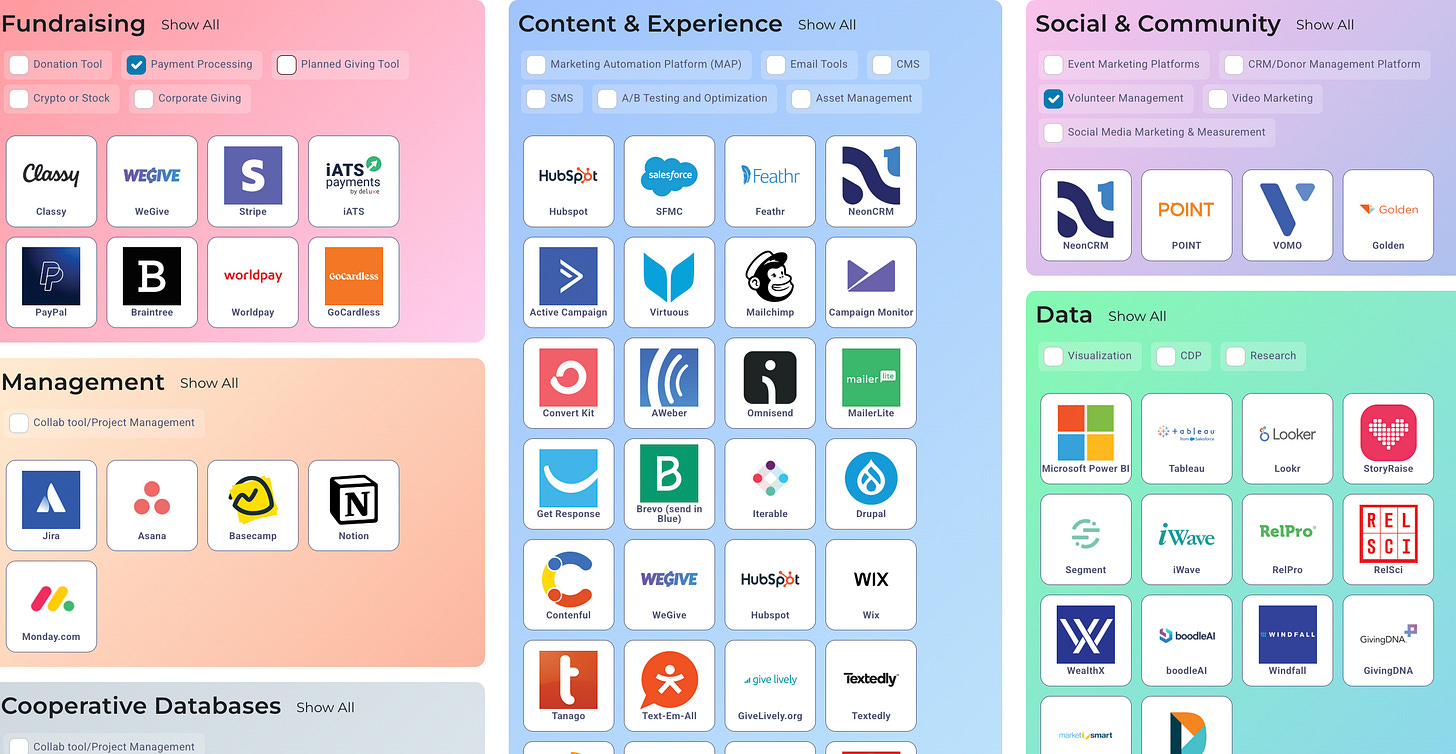140. SPN: Building an Internal Creative OS
Plus, digital ad' transparency and “brand safety”; and, plenty of Jobs
A very warm welcome to all the new subscribers.
You’ve joined a community of 2k+ marketing and fund raising operators at mission-driven Org’s. I’m thrilled to have you as readers and truly appreciate your feedback and support.
Get more matched gifts and drive more revenue for your Org!
Fundraise Up’s integration with Double the Donation’s 360MatchPro platform powers the most advanced company matching integration in the nonprofit industry.
I’ve landed more eligible matches because of it and offered tens of thousands of donors the opportunity to further their impact.
Game-changer? It is for me.
In this week’s SPN →
How to allocate a media budget
Building an Internal Creative OS
Digital advertising transparency and “brand safety”
Creative is the new targeting
and, plenty of Jobs & Opps that took my fancy this week.
Let’s jump in!
Ads and Adtech
Is anyone surprised to learn that the drunken spending that characterizes open web programmatic funds the worst sort of online content?
Yes, there are nonprofits in that ^ list.
Are we really surprised the brand safety vendors marked the sites as brand safe?
Gotta admit I find it pretty astonishing that Org’s and agencies continue to allow these problems to persist - by continuing to chase quantity rather than quality.
Whether your Org is called out in the list or not, it feels pretty imperative you ask your boss/vendor/agency/supplier to confirm that your Org:
Doesn’t buy from programmatic resellers.
Has a KYC policy for all direct supply relationships (“Know Your Customer”).
Ensure that your ad tech vendors do too.
Can’t believe that any Org who did these things would have been running on that site.
Also, Agencies seem very keen at the moment to toss platforms’ brand lift studies out there. Even though people from Meta and Google challenged a recent study by Braun & Schwartz, some comments appear to relish the idea the platforms are not as effective as they appear. The cited study is here.
But this doesn’t show the double standards. No-one believes the errant open web apps have any effect but they provide mythical reach. And - let’s be honest - enough people feed off this flow for them to keep it going.
Channelling vibes from last week’s SPN #139 it highlights the chasm between media planning and media buying.
AMA published a helpful graphic for those using A-B testing tools trying to measure incremental lift:
Many smart people labor looking for smart effective ways to reach donors but the thinking can be compromised by agencies looking to fulfil contracts based on volume and share.
Google commissioned an interesting report published recently from Madison and Wall called “The Future Of Planning Is The Platform.” The report explores how marketers will plan their media budgets in a world where AI-driven platforms proliferate and potentially house a majority of marketer spending:
Here, here!
Regular SPN readers know I like to reference sectors outside of our own for inspo and insights, and we know the top CPG firms are all over marketing science as they try to understand whether their huge investments in marketing are justified. Many are developing their own Market Mix Models as they seek to own the insight rather than rent it from their Agencies.
I’d like to see some Agencies servicing our sector respond with their own thinking - “actionable insights to help nonprofit Org’s navigate the Algorithmic Era with confidence.” Any volunteers?
Jobs & Opps 🛠️
If you have any jobs that you’d like me to profile just send them to me.
YMCA of Greater New York: Director, Digital Content & Social Media ($90,000 - $115,000)
Bath & Body Works: Community Relations Specialist
Action Aid: Digital Fundraising Lead (£59,000)
World Animal Protection: Head of Research (£59,983)
The New York Historical: Manager, Social Media ($70,000-$80,000)
Americares: VP, Philanthropy & Partnerships ($173,400 - $197,000)
British Heart Foundation: Manager, Senior Delivery (£65,000 - £67,500)
Wellcome Trust: Senior Content & Social Media Producer (£60,900)
→ More jobs updated daily to SPN’s sister website: www.pledgr.com
Allocating a Media Budget
As a follow on from last week’s deep dive into Audience Strategy > Media Strategy > Media Planning I received three replies all asking the same question: how to allocate a media budget.
The answer is “It Depends”. It depends on your phase of growth, seasonality, existing demand and Org competition.
But since it’s early’ish in Q1 and if you’re looking for RESET MODE or looking to advance your digital maturity you can at least start like this:
Performance : Brand
A. Ramp up with Performance - 100:0
This can quickly start generating traction with stable and predictable results.
✅ It helps with short-term growth.
B. Add demand generation tactics - 80:20
Start experimenting with tactics without direct results and monitor positive signals.
✅ Lean into a long-term mindset.
C. Expand to 50:50
You found working tactics, and messages and got the first results from your strategy. Time to expand.
✅ Well-balanced, sustainable growth.
D. Scale to 25:75
For long-term growth and assuming strong donor retention, your brand activities will exceed the performance budget.
✅ To scale for the long term, your brand is going to drive the biggest impact.
Org’s operating in the variant A stage often seem to face the same problems after 1-2 year of scaling their campaigns. The growth slows. Donor acquisition costs increase. ROI gets lower and lower.
For awhile it makes sense to rely solely on performance marketing campaigns. Your donor acquisition costs are going to be higher. There’s enormous value in building a brand to increase long-term ROI. And it feeds donor LTV.
Marketing & Fundraising Technology Landscape (link)
Building an Internal Creative OS
Truth is, creative can get over complicated internally at an Org.
Getting from start to finish quickly is often a slog. My experience is that it’s the small Org’s doing circa $1-5M in IG annual revenue and large Org’s doing $25M+ in IG who tend to move very quickly around creative decisions and be willing to test and learn quickly, allowing them to grow fast.
The middle group - meh. Molasses!
Content has evolved SO much over the last 5 years - the formats, the lengths, the structure, what catches attention, what creates emotion, etc.
We can’t simply approach ads the same way we did 10 years ago because the environment it’s displayed within is wildly different now.
Donors also no longer choose what appears on their feed; to anyone scrolling on their iPhones, every piece of content, ad or not, is basically served like an ad - they’re not following all the pages serving them content, therefore it may or may not catch someone’s attention.
The Following feed → For You feed shift has elevated the quality of ads and forced Org’s to really build their brand equity, and be more disciplined about their creative testing.
Similarly to how the Following feed has now changed to the For You feed by default, on the ads side, the shift is that platforms are now running campaigns that leverage their own algorithms to find you new donors, versus you needing to setup manual targeting. For the sake of today’s SPN, think of these as their AI-driven campaign setups.
On Meta, it’s called Advantage+. On Google, it’s Performance Max. On TikTok, it’s Smart+ campaigns. In all of these instances, your ad creative and the contextual clues within it that the platforms pick up become the targeting for the creative. Creative truly is the new targeting.
There are rumors that Meta is going to take away targeting altogether.
The more website events you can fire on your website, which means you have people coming to your website, donating on your site, or even donating through partner websites, the more the ad platforms will know/learn about your donor, and target these AI-driven campaigns better.
Zero party data (attributes to first-party data records) and first-party data learnings are incredibly important signals to the ad platforms. In order to do this, you need to develop a good practice around high-volume creative output, testing, analysis and iteration.
Don’t let 2 ad creatives drive the majority of your prospecting spend.
→ Within your ad accounts, setup a creative testing program with your agency or anybody internally who puts in the media buys to decide on a cadence (weekly or bi-weekly) of loading in fresh creative. Test it across your testing audience (broad, lookalikes, interests). Take the winning ad post ID’s and put them into your scaling campaigns. Whatever isn’t working, cut it and go back to the drawing board. For everything that is working, make a variety of creative iterations to find another winning creative.
→ If you have a video that takes off, test that same hook with different scenes following. If you have a static ad that worked well, try that same format with different copy. Or, keep the same copy and test it on other designs.
SPN Tip: Get comfortable in platforms like Figma, where you can take a static ad design, plug the winning copy into ChatGPT, come up with 25 other options for headlines, put it into the Figma file, export all 25 versions and get them uploaded into ads manager within 20 minutes. Click this ChatGPT conversation to see how I did it as an example.
Taking templates inside Figma and making iterations can be done by you, your media buyer (doesn’t have to be a designer), offshore talent or AI. Whatever which way, it’s a very scaleable route and allows you to scale your very own creative operating system of sorts.
OK, that’s all for today.
I hope you’ve found one nugget today that you can put into play next week.
If you enjoyed this SPN, please consider sharing with your network. Thank you to those that do.
If a friend sent this to you, get the next edition of SPN by signing up below.
And huge thanks to this Quarter’s sponsor Fundraise Up for creating a new standard for online giving.
Weekly Reads
YouTube Surprise: CEO Says TV Overtakes Mobile as “Primary Device” for Viewing (Hollywood Reporter)
Create AI-optimized TV advertising campaigns with Brand+ (The Keyword)
Delivering ad relevance without third-party cookies: advanced AI-powered contextual techniques (Amazon Ads)
Meta’s Hyperscale Infrastructure: Overview and Insights (Association for Computing Machinery)
How Amazon Blew Alexa’s Shot to Dominate AI (Fortune)
Anthropic Expected to Raise $2 Billion in Megaround (Bloomberg)
What’s the best date for a footballer to be born on – and is it February 5? (NYTimes)
TikTok SEO: The ultimate guide (Search Engine Land)
How Lantern will bring outcome measurement to TV (The Media Leader)
The man who robbed banks for a living would love working in programmatic CTV ads (MediaPost)







